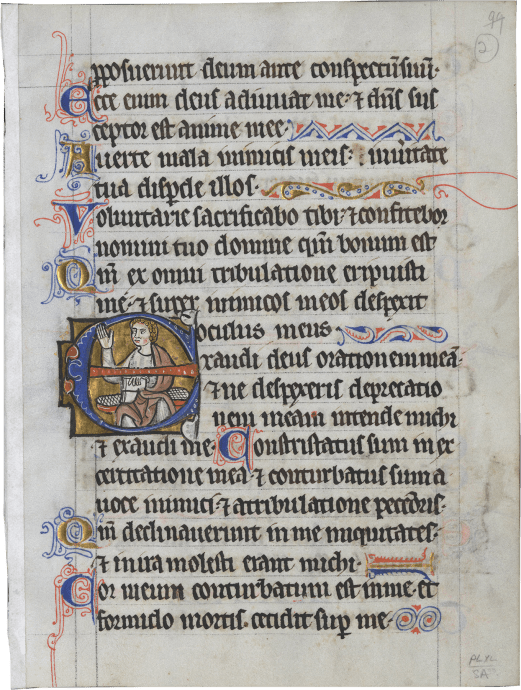



Description
This leaf, illustrating King David Holding a Book in a 4-line initial E (Psalm 54, Exaudi, deus, orationem meam… [Hear my prayer, O God]) comes from the famous Rosenbaum Psalter-Hours. In addition to the initial showing David raising his hand in prayer executed in colors on highly burnished gold leaf, the leaf includes on its recto and verso numerous decorative line endings in red and blue penwork.
Thanks to Peter Kidd, among others, we now know quite a lot about the parent manuscript. It was lavishly illuminated with historiated initials for every Psalm, clearly for a person of considerable wealth, a nun or an abbess from a Benedictine monastery. The text of one collect refers to “the community of this holy monastery,” and the text of another refers to “our abbess.” The intercession of the Virgin Mary and St. Benedict are sought (Kidd, 2019, p. 106). Just where this monastery was located remains open to question. Scholars have suggested an English origin based in part on the type of decorative line endings, as well as other peculiarities in the cycle of illumination (Fliegel, 1999, no. 12-23, from the collection of Jeanne Miles Blackburn). Kidd, Plotzek, and others favor the area of Flanders or the Rhine-Meuse region (Plotzek, 1987, no. 8; Kidd, 2019, no. 20, pp. 106-109). More than 40 leaves have been identified to date, and the parent manuscript – dismantled by 1966 – included the Psalms, canticles, litany and collects, followed by the Hours of the Virgin and the Office of the Dead. Based on old foliation, Kidd suggests that the manuscript also included an illuminated calendar and perhaps a full-page prefatory cycle. It takes its name from the provenance of many of the leaves in the Chicago collection of Esther Rosenbaum (d. 1980), sold at Sotheby’s London on 25 April, 1983, lot 69. Relatively complete lists of the folios are found in Sotheby’s London, July 7, 2015, lot 13 and in Peter Kidd’s Provenance Blog (see below).
For arguments in favor of an English origin, see the following stylistic comparisons: the “Grandisson Psalter” and the “Salvin Hours” (London, British Library, Add. MSS. 21926 and 48985; see Nigel Morgan, Early Gothic Manuscripts II: 1250-1285, London, 1988, nos. 165, 158) or the “Windmill Psalter” (New York, Pierpont Morgan Library, MS M. 102). For the Flemish or Rhine-Meuse origin, compare the group of Psalters related to Lambert le Bègue in Liege discussed by Keith Sinclair and Judith Oliver (see especially University of Liege, Library, MS 431; https://donum.uliege.be/handle/2268.1/1508).
Literature:
Peter Kidd, “A Lavishly Illuminated 13th-Century Psalter-Hours Made for a Nun (I and II)”
https://mssprovenance.blogspot.com/2015/06/a-lavishly-illuminated-13th-century.html;
Peter Kidd, The McCarthy Collection, vol. II, Spanish, English, Flemish, and Central European Miniatures, London, 2019, no. 20.
London, Sotheby's catalogue, July 7, 2015, lot 13;
Keith Sinclair, “Les manuscrits du psautier de Lambert le Bègue,” Romania 86 (1965), pp. 22–47;
Judith Oliver, Gothic Manuscript Illumination in the Diocese of Liège (c. 1250 - c. 1330), Corpus of Illuminated Manuscripts from the Low Countries, 2 vols. Louvain, 1988; vol. I, 38-29